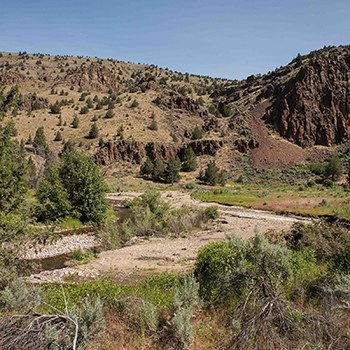Have you heard the news? Last year, the Land Trust conserved the 4,500 acre Priday Ranch, located north of Madras. With three creeks running through the property, a rimrock canyon ideal for golden eagles and other wildlife, sagebrush steppe, and native grasslands, it’s an incredible place that is now protected forever. But, that’s not all, it’s also a property that helps address the impacts of climate change.
Since the Land Trust protects land forever, it’s important for us to not only think about what plants and animals we’re helping now, but to also think about what plants and animals might call places like Priday Ranch home in the future. When you factor climate change into that future, one of our goals is to ensure that the plants and animals present are able to move through and between our protected lands.
Terrestrial resilience can be broken down into separate parts. Soil, rock, slope angle, and slope direction are all considered geophysical features that support the diversity of life on land. More diversity in geophysical features means more microclimates and a more varied range of plants and animals in the area. Now, let’s add connectivity to this picture. Connectivity is the ability of a plant or animal to successfully move across and between different areas in order to survive and thrive. Taken together, a diversity of geophysical features plus high connectivity provides terrestrial resilience. Written another way:
Diversity of geophysical features + high connectivity = terrestrial resilience
The higher the terrestrial resilience in an area, the more likely the area (and the plants and animals within it) will be able to withstand or bounce back from the effects of a changing climate.
How does this relate to Priday Ranch? The property is predominantly either above average or far above average in terms of its terrestrial resiliency. It has low-lying areas where Trout Creek, Antelope Creek, and Ward Creek wind their ways through meadows and canyons. There are also rolling hills, rugged highlands, and rimrock canyons. Overall, Priday Ranch has a wide variety of elevations and slope angles and other geophysical features. In addition, the surrounding lands are sparsely developed, which helps wildlife move in, across, and out of our protected lands, giving the property high connectivity. Added together, all of these factors mean Priday Ranch has the terrestrial resiliency that will help it (and us!) weather the impacts of climate change into the future.
Learn More:
- Read more on the Deschutes Land Trust's Climate Change Strategy
- Dig deeper with Cool Words for Hot Times: Connectivity
- Get a closer look at Priday Ranch with a Virtual Tour


